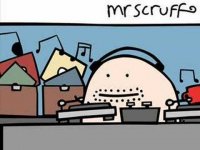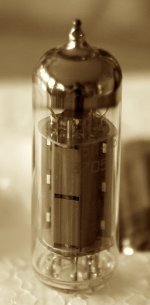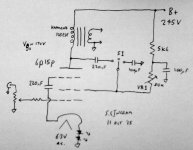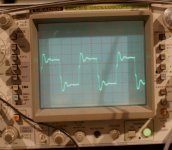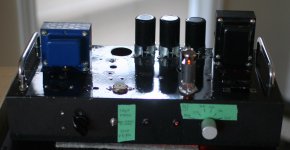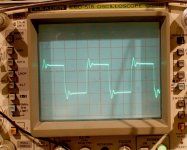Member
Joined 2009
Paid Member
Well it is definitely mysterious.
There is are too many variables going on - not least are the differences between speakers where I'm descending into the vagaries of 'voicing' for a particular driver.
I'm finding that the tonal balance varies in subtle ways between 5k and 2k5 load; between low and high volume, between zero, 2nF and 220nF of plate to screen feedback. It's a tweaks paradise, or a tweaks hell.
There is a good deal of flexibility but I'm wondering if the single tube amp is a personal thing. And with tetrode/pentode having a relatively high output impedance there is a lot more speaker interaction going on.
It's a clean and open sound with good bass; the envy of many. My ears prefer more hi-end roll-off with single full range drivers but this can easily rob them of their signature vitality.
I think 2nF of plate to screen feedback (5k load) provides the best balance with my Audio Nirvana 15" speaker. The top-end hiss is gone, the treble open and lively, the bass strong and overall it sounds way better than I thought was possible using a single tetrode gain/power stage. I prefer this to lots of screen feedback (triode mode) because it retains more gain, sounds lively.
There is are too many variables going on - not least are the differences between speakers where I'm descending into the vagaries of 'voicing' for a particular driver.
I'm finding that the tonal balance varies in subtle ways between 5k and 2k5 load; between low and high volume, between zero, 2nF and 220nF of plate to screen feedback. It's a tweaks paradise, or a tweaks hell.
There is a good deal of flexibility but I'm wondering if the single tube amp is a personal thing. And with tetrode/pentode having a relatively high output impedance there is a lot more speaker interaction going on.
It's a clean and open sound with good bass; the envy of many. My ears prefer more hi-end roll-off with single full range drivers but this can easily rob them of their signature vitality.
I think 2nF of plate to screen feedback (5k load) provides the best balance with my Audio Nirvana 15" speaker. The top-end hiss is gone, the treble open and lively, the bass strong and overall it sounds way better than I thought was possible using a single tetrode gain/power stage. I prefer this to lots of screen feedback (triode mode) because it retains more gain, sounds lively.
Last edited:
Member
Joined 2009
Paid Member
Member
Joined 2009
Paid Member
I've built a couple Spud amps with the 6p15p and it's a great tube. But if you use it with speakers under 95db at 1 watt it will probably need an active preamp or at least a 2v source to sound best.
Member
Joined 2009
Paid Member
Hi Joel,
Did you use this tube as triode-wired, or pentode-wired ?
How are you planning on wiring it? Going to go triode strapped?
I looked at my stash of tubes last night and I've got a mini-pentode that I might try but I was worried that it wouldn't have enough drive.
Member
Joined 2009
Paid Member
I was attracted to the comments people have made regarding the Jef Larson circuit which is a pentode mode circuit. But I have seen data around on the internet showing very nice tiode-curves. It makes sense to try both ways and compare them - I'll have to look at what I can do using my experimental chasis. There are a lot of pentodes out there to chooe from of course which adds to the fun!
I used Pentode. Use the screen resistor(g2) to adjust feedback if necessary. I had 308V on the plate and about 200V on the screen at about 38mA or so. Also try a 400V rated .1 uf cap from G3 to ground.
Triode this tube does sound good, but needs about 8 volts to drive, so would not work as a "Spud"
Triode this tube does sound good, but needs about 8 volts to drive, so would not work as a "Spud"
Last edited:
Member
Joined 2009
Paid Member
I used Pentode. Use the screen resistor(g2) to adjust feedback if necessary. I had 308V on the plate and about 200V on the screen at about 38mA or so. Also try a 400V rated .1 uf cap from G3 to ground.
Triode this tube does sound good, but needs about 8 volts to drive, so would not work as a "Spud"
Your experience matches up well with Jeff's design and what has been written over on Hawthorne Audio. I have that 0.1uF cap in the schematic in post #22. My OPT doesn't have an 8k load option, I can try it 5k and 10k.
Member
Joined 2009
Paid Member
Good, I can use the current OPT. For B+, my experimental chasis is providing around 250V, a bit less if I pull 40mA through it. It's choke input after the rectifier so if I put a small cap after the diodes I'll be able to bring B+ up higher. I will have to look what I've got in my junk box to use as that first capacitor.
Member
Joined 2009
Paid Member
Unfortunately, I wasn't able to find any suitable caps to put after the rectifier to raise B+ above 245V. I tried a 500V rated 20uF cap but it gave me 380V and since I have a few 315V caps in the circuit this isn't going to be safe. So I decided to at least install another 9-pin socket int the experimental chassis and wire it up for the 6p15p.
Just for the fun of it I installed the tube and ran it first with the lower B+. I measured 180V on g2, 3.8V on the cathode, 240V or so on the plate. The power supply was giving out 35mA or thereabouts for total B+ current.
And just for fun I hooked it up to the speaker and gave it a very brief play (it's late and somebody upstairs complained after 2 seconds!).
It sounds not too bad at all. For the brief time I heard it at low volume I didn't get a sense of any harshness. However, bass was clearly lacking. Will explore more tomorrow evening 🙂
p.s. Review of Jef's amp over at Hawthorne also reports lightweight bass
http://www.hawthorneaudio.us/forums/viewtopic.php?f=11&t=1263
and similar from Joel
http://www.diyaudio.com/forums/swap-meet/256579-fs-6cl6-spud-amp.html
But I will explore more.
Just for the fun of it I installed the tube and ran it first with the lower B+. I measured 180V on g2, 3.8V on the cathode, 240V or so on the plate. The power supply was giving out 35mA or thereabouts for total B+ current.
And just for fun I hooked it up to the speaker and gave it a very brief play (it's late and somebody upstairs complained after 2 seconds!).
It sounds not too bad at all. For the brief time I heard it at low volume I didn't get a sense of any harshness. However, bass was clearly lacking. Will explore more tomorrow evening 🙂
p.s. Review of Jef's amp over at Hawthorne also reports lightweight bass
http://www.hawthorneaudio.us/forums/viewtopic.php?f=11&t=1263
and similar from Joel
http://www.diyaudio.com/forums/swap-meet/256579-fs-6cl6-spud-amp.html
But I will explore more.
Attachments
Last edited:
The bass issue I had was from the small OPT used in the original kit. Depending on your PS and output transformer YMMV.
You could try cathode feedback from the speaker output (+) to the top of the cathode resistor (I used a bipolar Nichicon Muse). So if you already have a cathode bypass cap, disconnect the bottom end and connect that to the speaker out.
You could try cathode feedback from the speaker output (+) to the top of the cathode resistor (I used a bipolar Nichicon Muse). So if you already have a cathode bypass cap, disconnect the bottom end and connect that to the speaker out.
Member
Joined 2009
Paid Member
I think I had some fletcher-munson going on - with the volume up there's no issue with the bass now. It goes plenty deep. Maybe not as punchy as the 6E5P - but then it does have a higher plate resistance. It's also got the same open and lively sound as the 6E5P which with my hearing means it sounds harsh on the 'cheap stations' on FM with some material. But even with digital through a U2 dac the sound is tilted upwards giving it an open and forward presentation.
Member
Joined 2009
Paid Member
Ringing on the output
The lively sound maybe related to the tendency for the output to bounce after a sharp transition.
Here's a scope trace of the output with a 5kHz (baseline) square wave and an 8R resistor dummy load. There's quite an overshoot - the ringing looks reasonably well damped but the overshoot is not what I want to see. Looks like this SPUD became Crinkly Fries 😱
It seems independent of the g2 voltage but the overshoot and ringing does vary in extent depending on whether I use the 5k or 2k5 tap. I tried a simple zobel (13R + various caps) across the OPT secondary and I can reduce the overshoot but I can't tame it to the point where it is acceptable.
The lively sound maybe related to the tendency for the output to bounce after a sharp transition.
Here's a scope trace of the output with a 5kHz (baseline) square wave and an 8R resistor dummy load. There's quite an overshoot - the ringing looks reasonably well damped but the overshoot is not what I want to see. Looks like this SPUD became Crinkly Fries 😱
It seems independent of the g2 voltage but the overshoot and ringing does vary in extent depending on whether I use the 5k or 2k5 tap. I tried a simple zobel (13R + various caps) across the OPT secondary and I can reduce the overshoot but I can't tame it to the point where it is acceptable.
Attachments
Member
Joined 2009
Paid Member
Try Edcor GXSE15-8-3.5
I have now hooked up an Edcor OPT to compare. This one has a fixed load at 3k5 otherwise similar spec.
Firstly, the ringing on the output with square waves is a little less but the overshoot is about the same. No real change there.
I also wired in a switch so that I can try the difference between having a large electrolytic to ground on g2 or not.
Listening: The Edcor is missing something, not sure how to describe it. There is bass but not quite as deep and the mids are not as smooth. I'm surprised, but my ears prefer the Hammond.
Switching out the cap off g2 means a reduction in gain due to degenerative feedback at the screen grid. Compensating with the volume control allows a comparison still. Without the bypass cap it's a little smoother to my ears.
p.s. I tried the UL tap (40%) - sounds louder but not nice at all.
The Edcor is coming out and the Hammond is going back in.
I have now hooked up an Edcor OPT to compare. This one has a fixed load at 3k5 otherwise similar spec.
Firstly, the ringing on the output with square waves is a little less but the overshoot is about the same. No real change there.
I also wired in a switch so that I can try the difference between having a large electrolytic to ground on g2 or not.
Listening: The Edcor is missing something, not sure how to describe it. There is bass but not quite as deep and the mids are not as smooth. I'm surprised, but my ears prefer the Hammond.
Switching out the cap off g2 means a reduction in gain due to degenerative feedback at the screen grid. Compensating with the volume control allows a comparison still. Without the bypass cap it's a little smoother to my ears.
p.s. I tried the UL tap (40%) - sounds louder but not nice at all.
The Edcor is coming out and the Hammond is going back in.
Attachments
Member
Joined 2009
Paid Member
The Hammond was re-installed. I have used an RC snubber across the OPT primary to kill the ringing. No discernible change in the sound. Snubber removed.
I've gone through a similar set of experiments now as I did with the 6E5P. Overall, I prefer the sound of the 6p15p with some plate to g2 feedback using a 220nF film capacitor. It reduces the gain by around a factor of 2 and cleans up the signal without taking anything away from it.
Removing the large cap bypass from g2 (without plate feedback) reduces gain but doesn't clean up the sound, in fact it sounds dirtier at higher volume. It might at first seem more mellow, but it's a grungy mellow and not a good approach.
I don't know if I would call this triode mode, the gain didn't drop enough for that but it must be some kind of triode like connection. I wonder if this method eliminates the pentode partition noise at high frequencies since the h.f. currents are now recombined at the plate ?
So, next up, a shoot-out between the 6p15p and the 6e5p......
I've gone through a similar set of experiments now as I did with the 6E5P. Overall, I prefer the sound of the 6p15p with some plate to g2 feedback using a 220nF film capacitor. It reduces the gain by around a factor of 2 and cleans up the signal without taking anything away from it.
Removing the large cap bypass from g2 (without plate feedback) reduces gain but doesn't clean up the sound, in fact it sounds dirtier at higher volume. It might at first seem more mellow, but it's a grungy mellow and not a good approach.
I don't know if I would call this triode mode, the gain didn't drop enough for that but it must be some kind of triode like connection. I wonder if this method eliminates the pentode partition noise at high frequencies since the h.f. currents are now recombined at the plate ?
So, next up, a shoot-out between the 6p15p and the 6e5p......
The spud amp is amazing; but the fresh fries look delicious.......
Should we call you Carlos??
Interesting comment about the OPT. They also say it makes a difference. I built a 6EM7 SET ten years back and it remains the best 'radio' amp I have. Great for news broadcasts!
Hugh
Should we call you Carlos??
Interesting comment about the OPT. They also say it makes a difference. I built a 6EM7 SET ten years back and it remains the best 'radio' amp I have. Great for news broadcasts!
Hugh
- Home
- Amplifiers
- Tubes / Valves
- Yukon Gold - a spud amp

